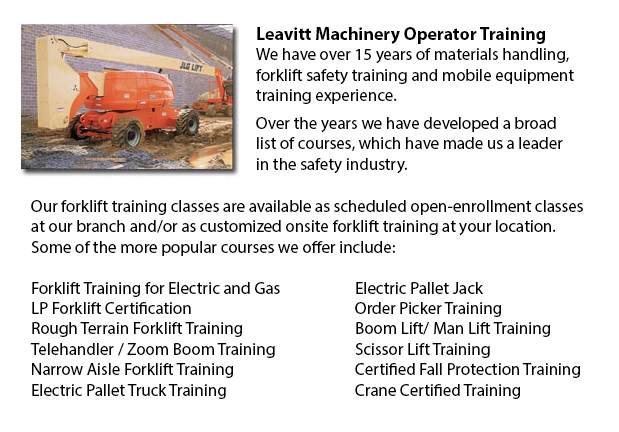
Kelowna Aerial Lift Safety Training - Each and every year, there are roughly 26 construction deaths attributed to the use of aerial lifts. Most of the craftsmen killed are electrical workers, laborers, painters, ironworkers or carpenters. The majority of the deaths are caused by electrocutions, falls and tip-overs. The greatest hazard is from boom-supported lifts, such as bucket trucks and cherry pickers. Nearly all fatalities are related to this particular type of lift, with the rest involving scissor lifts. Other risks include being struck by falling things, being thrown out of a bucket, and being caught between the guardrail or lift bucket and a thing, like a joist or steel beam.
In order to operate an aerial lift safely, perform an inspection on the following items before utilizing the device: operating and emergency controls, safety devices (such as, outriggers and guardrails), personal fall protection gear, and wheels and tires. Inspect for possible leaks in the air, fuel-system, hydraulic fluid. Inspect the device for loose or missing components.
The places that worker would utilize the aerial device must be inspected carefully for possible dangers, like for example holes, bumps, debris and drop-offs. Overhead powerlines have to be avoided and monitored. It is recommended that aerial lift devices be used on stable, level surfaces. Never work on steep slopes that go beyond slope limitations specified by the manufacturer. Even on a level slope, brakes, wheel chocks and outriggers must be set.
Companies should provide their aerial lift operators with the correct guidebooks. Operators and mechanics must be trained by a licensed individual experienced with the relevant aerial lift model.
Aerial Lift Safety Guidelines:
o Close doors or lift platform chains before operating.
o Do not lean over or climb on guardrails. Stand on the floor of the bucket or platform.
o Stay within manufacturer's load-capacity limits.
o Use work-zone warnings, such as signs and cones, when working near traffic.
If right procedures are followed, electrocutions are preventable. Stay at least 10 feet away from any power lines and certified electricians must de-energize and/or insulate power lines. Individuals working should use personal protective tools and equipment, like a bucket which is insulated. Nonetheless, a bucket which is insulated does not protect from electrocution if, for example, the person working touches another wire providing a path to the ground.
When in the bucket, workers have to prevent possible falls by securing themselves to the guardrails by utilizing a positioning device or a full-body harness. If there is an anchorage in the bucket, a positioning belt together with a short lanyard is adequate.
By following the manufacturer's directions, tip-overs can be avoided. Never drive the lift platform whilst it is elevated, unless otherwise specified by the manufacturer. Follow the vertical and horizontal reach limits of the device, and never go beyond the specified load-capacity.
-
Kelowna Forklift Training Program
Kelowna Forklift Training Program - The lift truck is a common powered industrial vehicle which is in wide use these days. They are sometimes called hi los, lift trucks or jitneys. A departments store would use the forklift to unload and load merchan... More -
Kelowna Crane License
Kelowna Crane License - Crane operators ought to be "credentialed", that means they ought to have a crane operator certification or license. Credentialing is considered a mandatory governmental requirement in order to practice as an operator of a cra... More -
Kelowna Boom Lift Safety Training
Kelowna Boom Lift Safey Training - Boom lifts fall under the type of elevated work platform or aerial lifting device. Most usually used in warehousing, construction and industry; the boom lift is so versatile that it could be utilized in almost whate... More -
Kelowna Loader Training
Kelowna Loader Training - Loader Training - Any individual who would like to operate a forklift should take a Loader Training course in order to become a certified forklift truck operator. There are a variety of ways to obtain forklift training. Cour... More -
Kelowna Crane Ticket
Kelowna Crane Ticket - Modern cranes can either be simple or complex, based upon the nature of the application they can carry out. For example, mobile cranes are somewhat simple units. A telescopic boom and even a steel truss mounts its movable platf... More -
Kelowna Boom Lift Operator Training
Kelowna Boom Lift Operator Training - The cherry picker work platform is a type of work platform, that will typically have a bucket or platform at the end of a hydraulic lifting system. The machine is likewise referred to as a man lift, boom lift, hy... More -
Kelowna Heavy Equipment Ticket
Kelowna Heavy Equipment Ticket - Depending on the nature of the job at hand, the kind of construction equipment that a heavy equipment operator makes use of differs. Every kind of machine is made to perform particular tasks in the most effective mann... More -
Kelowna Bucket Truck Training
Kelowna Bucket Truck Training - The bucket truck training program is a program that is intended to effectively train qualified operators so they can reduce the possibility of incident and personal injury while working with or in close proximity to bu... More

Leavitt Operator Training
TOLL FREE: 1-888-254-6157
101-864 McCurdy Place
Kelowna, British Columbia
forkliftcertificationkelowna.com
Email Us
About Us


